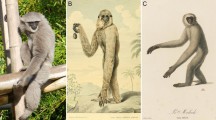Abstract
In 1914 Hustedt presented a monographic revision of the genus Tetracyclus Ralfs. His paper was a detailed account of his investigations made for the illustrations of the genus in Schmidt's Atlas. Hustedt made a particularly detailed study of the species T. ellipticus and outlined his ideas of the interrelationships between the subspecific taxa he understood to be “organised” around the nominate type. The monograph was unusual (and unique) in that Hustedt included a schematic diagram which represented his views on the “interrelationships” of symmetry characters observed between the various subspecific taxa he recognised. I show that Hustedt's diagram can be related to a particular understanding of both species definitions and taxonomic practice and that others who have followed Hustedt (by implication) move further away from, rather than closer to, the data they are attempting to explain in a systematic framework.
Similar content being viewed by others
References
Bailey, J. W., 1845. Notice of some new localities of infusoria, fossil and Recent. Am. J. Sci. Arts 48: 321–343.
Bonik, K., 1982. Gibt es Arten bei Diatomeen? Eine evolutionsbiologische Deutung am Beispiel der Gattung Nitzschia. Senckenbergiana biol. 62: 413–434.
Edgar, R. K., 1979. J. W. Bailey and the diatoms of the Wilkes Exploring Expedition (1838–1842). Occ. Pap. Farlow Herbm Cryptogam. Bot. 14: 9–33.
Ehrenberg, G. C., 1843. Mitteilung über 2 neue asiatische Lager fossiler Infusorien-Erden aus dem russischen TransKaukasien (grusien) und Siberien. Ber. Akad. wiss. Berl. 1843: 43–49.
Ehrenberg, G. C., 1845. Neue Untersuchungen über das kleinste Leben als geologisches Moment. Ber. Akad. wiss. Berl. 1845: 53–88.
Ehrenberg, G. C., 1854. Mikrogeologie. Das Erden und Felsen schaffende Wirken des unsichtbar kleinen selbstandigen Lebens auf der Erde. Leopold Voss, Leipzig, 374pp.
Grant, V., 1957. The plant species in theory and practice. In E. Mayr (ed.), The Species Problem. Amer. Assoc. Adv. Sci. Publ. 50: 39–80.
Hagen, J. B., 1983. The development of experimental methods in plant taxonomy, 1920–1950. Taxon 32: 406–416.
Hermann, O. & H. Reichelt, 1893. Ueber Diatomeenschichten aus der Lausitz. Ber. Naturf. ges. Leipzig, Jahrgang 1892/1893: 67–76.
Hustedt, F., 1912. In A. Schmidt, Atlas der Diatomaceenkunde. Heft 71, t. 281–284, R. Reisland, Leipzig.
Hustedt, F., 1914a. Die Bacillariaceen-Gattung Tetracyclus Ralfs; kritische Studien über Ban und Systematik der bisher beschriebenen Formen. Abhandl. naturwiss. Verein Bremen. 23: 90–107.
Hustedt, F., 1914b. Bacillariales aus den Sudeten und einigen benachbarten Gebieten des Odertales. Arch. Hydrobiol. Plankt. 10: 1–128.
Kociolek, J. P. & E. F. Stoermer, 1988. Taxonomy, ultrastructure and distribution of Gomphoneis herculeana, G. eriensis and closely related species (Naviculales: Gomphonemataceae). Proc. Acad. Nat. Sci. Philadelphia. 140: 24–97.
Lam, H. J., 1936. Phylogenetic symbols, past and present. Acta biotheor. 2: 153–194.
Lange-Bertalot, H. & R. Simonsen, 1978. A taxonomic revision of the Nitzschia lanceolatae Grunow. 2. European and related extra-european freshwater and brackish water taxa. Bacillaria 1: 11–111.
Lotsky, J. P., 1916. Evolution by means of hybridisation. Martinus Nijhoff, The Hague, 166 pp.
Mann, D. G., 1982. The use of the central raphe endings as a taxonomic character. Pl. Syst. Evol. 141: 143–152.
Mann, D. G. & J. P. Kociolek, 1990. The species concept in diatoms: Report on a workshop. In H. Simola (ed.), Proceedings of the 10th International Diatom Symposium, O. Koeltz, Koenigstein: 577–583.
Mayr, E., 1982. The growth of biological thought. Harvard University Press, Cambridge, Mass.
Nelson, G., 1989a. Cladistics and evolutionary models. Cladistics 5: 275–289.
Nelson, G., 1989b. Species and taxa: systematics and evolution. In D. Otte & J. A. Endler (eds), Speciation and its consequences, Sinauer Assoc., Sunderland: 60–81.
Nelson, G. & P. Ladiges, 1990. Biodiversity and biogeography. J. Biogeogr. 17: 559–560.
Nelson, G. & N. I. Platnick, 1981. Systematics and biogeography: Cladistics and vicariance. Columbia University Press, New York.
Patterson, C., 1988. The impact of evolutionary theories on systematics. In D. L. Hawksworth (ed.), Prospects in Systematics, Clarendon Press, Oxford: 59–91.
Silva, P. C., 1984. The role of extrinsic factors in the past and future of green algal systematics. In D. E. G. Irvine & D. M. John (eds), Systematics of the green algae, The Systematics Association Special Volume 27, Academic Press, London: 419–433.
Simonsen, R., 1987. Atlas and catalogue of the diatom types of Friedrich Hustedt. Vols 1–3. J. Cramer, Berlin.
Stevens, P. F., 1984. Metaphors and typology in the development of botanical systematics 1690–1960, or the art of putting new wine in old bottles. Taxon 32: 169–211.
Stevens, P. F., 1986. Evolutionary classification in botany, 1960–1985. J. Arn. Arb. 67: 313–339.
Stevens, P. F., 1990. Nomenclatural stability, taxonomic instinct, and flora writing — a recipe for disaster? In P. Baas, K. Kalkman & R. Geesink (eds), The plant diversity of Malesia. Kluwer Academic Publishers, Dordrecht: 387–410.
Theriot, E. C., 1992. Speciation in lacustrine centric diatoms of the Stephanodiscus niagarae complex (Bacillariophyceae): 1. Morphological evolution in geographic and environmental space. Syst. Biol., 41: 141–157.
VanLandingham, S. L., 1967. Paleoecology and Microfloristics of Miocene Diatomites from the Otis Basin Juntura Region of Harney and Malheur Counties, Oregon. Nova Hedwigia, Bieh., 26: 1–77.
Williams, D. M., 1986. Proposal to conserve the generic name Tetracyclus against Biblarium (Bacillariophyta). Taxon 35: 730–731.
Williams, D. M., 1987. Observations on the genus Tetracyclus Ralfs (Bacillariophyta) I. Valve and girdle structure of the extant species. Brit. J. phycol. 22: 383–399.
Williams, D. M., 1989. Observations on the genus Tetracyclus Ralfs (Bacillariophyta) II. Morphology and taxonomy of some species from the genus Stylobiblium. Brit. J. phycol. 24: 317–327.
Williams, D. M., 1990. Examination of auxospore valves in Tetracyclus from fossil specimens and the establishment of their identity. Diatom Res. 5: 189–194.
Williams, D. M., In press. Ontogeny and phylogeny in the genus Tetracyclus. Special Publications of the California Academy of Science.
Author information
Authors and Affiliations
Rights and permissions
About this article
Cite this article
Williams, D.M. Hustedt's study of the diatom species Tetracyclus ellipticus: why history is not just a chronicle of events. Hydrobiologia 269, 21–30 (1993). https://doi.org/10.1007/BF00028000
Issue Date:
DOI: https://doi.org/10.1007/BF00028000




